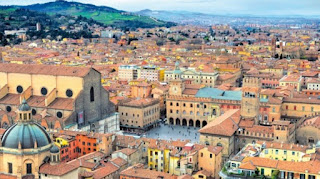Sunday afternoon … at Ravenna and Fathers Day lunches are everywhere … (A new landscapes for Malchkeoun to deposit her charitable hat)
Driving from Firenze to Ravenna across the challenging narrow high mountains was worth every curve… the motorbikes are driven by daredevils but the views are magical … having lunch at places like San Godenzo are one in the million
Ravenna’s mosiacs are a UNESCO World Heritage Site. And when you stand in front of them, you will quickly realise why. Precious gems and gold leaf sparkle in front of your eyes. The depictions, some of which are extraordinarily well preserved, are incredibly impressive, even for art laypeople like ourselves.
“Rugadh e ann am Florence agus bha e an sàs ann am beatha culturach is catharra a' bhaile mus do dh'fhuadaich na h-ùghdarrasan e ann an 1302. Dh'fhuirich e ann an grunn bailtean san Eadailt, leithid Verona is dh'imrich e do Ravenna ann an 1319, far an do choilean e am Paradiso is chaochail ann an 1321.[1]”
Episcopal Lineage / Apostolic Succession:
Essays & Opinions
The Monster of Ravenna, the Monk Calf, and, of course, the Pope Ass. Why were 16th-century luminaries printing pamphlets on monsters
We cannot be one hundred percent sure, but it’s very likely that during his last stay in Ravenna, Dante Alighieri visited the wonderful churches and basilicas of the city, today Unesco World Heritage, and that he admired the priceless treasures preserved inside.
Dante had already been in Ravenna before, presumably in 1303 and in 1310. He also wandered in the pine forest of Classe — «along the shore of Classe, through the pines» (Purgatorio, Canto XXVIII), which he describes as «forest-dense, alive with green, divine».
This is why Guido da Polenta, the lord of the city, did not trouble much to convince the Supreme Poet to come again to the ancient Byzantine capital in 1318, making it his last oasis of peace and tranquillityafter his long wanders far from Florence.
Here, Dante Alighieri had the opportunity to be together again with his family, and to end his cherished Divine Comedy.
Of course, the chance to have a source of income, thanks to the representation assignments conferred on him by Guido Novello as his ambassador in Venice to doge Giovanni Soranzo helped to convince him.
The bones seem to belong to one young man, one middle-aged, and one elderly. This matches the oldest known depiction of the Three Kings: this 6th century mosaic in Ravenna. There's a legend that they were martyred as Christians — all at the same time, as the bones would imply.
Destination of thousands of tourists visiting Dante’s Tomb every year, the so-called QUADRARCO OF BRACCIOFORTE is a little corner of tranquillity in the very heart of Ravenna.
The Quadrarco of Braccioforte is located in the so-called Zone of Silence, inextricably linked to the memory of the Supreme Poet.
In the 10th century, historian from Ravenna Andrea Agnello wrote in his chronicles that here, in the past, was a little oratory, connected through a portico to the nearby Basilica of San Francesco, which is no longer there today.
Legend has it that the name “Braccioforte” is connected with the story of two worshippers, who were willing to do anything in order to be listened by the Lord.
Right in the place of the monument, the two men had sworn an oath invoking the “strong arm” of Christ, in Italian “braccio forte”, in front of the Christ’s image that was preserved here.
DANTE AND THE QUADRARCO
The spoils of the Supreme Poet were buried where today is a little courtyard between Dante’s Tomb and the Basilica of San Francesco. They were buried there in order to keep them safe from the bombings of World War II.
A little mound of earth covered with ivy, right at the centre, takes us back to those memories. Here is a gravestone that says “Under this mound the bones of Dante found safe rest from 23 March 1944 to 19 December 1945”.
In truth, Dante’s spoils had never been in danger nor threatened by bombings. Nonetheless, in the name of an extreme safeguard, the fascist party official Alessandro Pavolini had made an agreement to move the poet’s remains in Valtellina (a valley in the Lombardy region) in case of danger.
The relationship between the Quadrarco and Dante resides also in other elements of the area – first of all an old wall that today has been restored, but used to border with the old Franciscan Cloisters.
Between the 16th and the 19th century, the spoils of the Poet were hidden by the friars more than once, in order to keep them safe from any pretenders – especially Florence.
Then, there is the imposing centuries-old oak, wanted by Giosuè Carducci to commemorate the Supreme Poet at the beginning of the 20th century. With its arms, the oak embraces and protects the entire area.
Lastly, there is the so-called “bell of Dante”on the top of a staircase, just behind the tomb.



